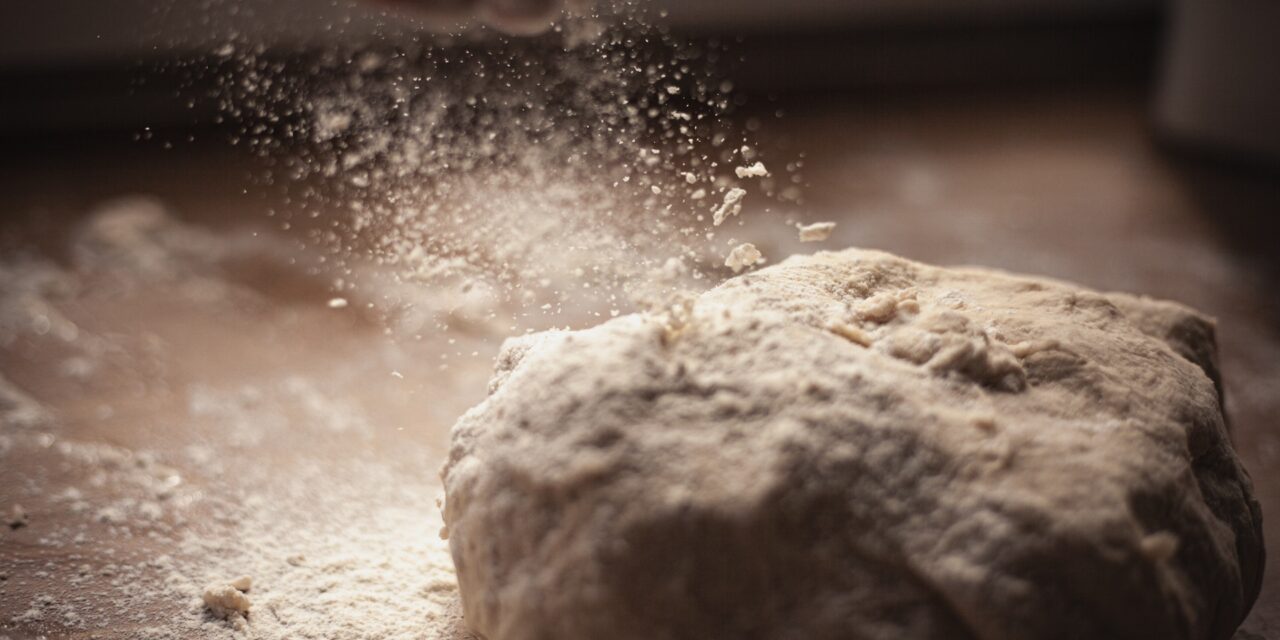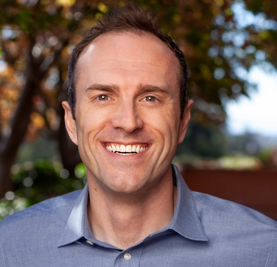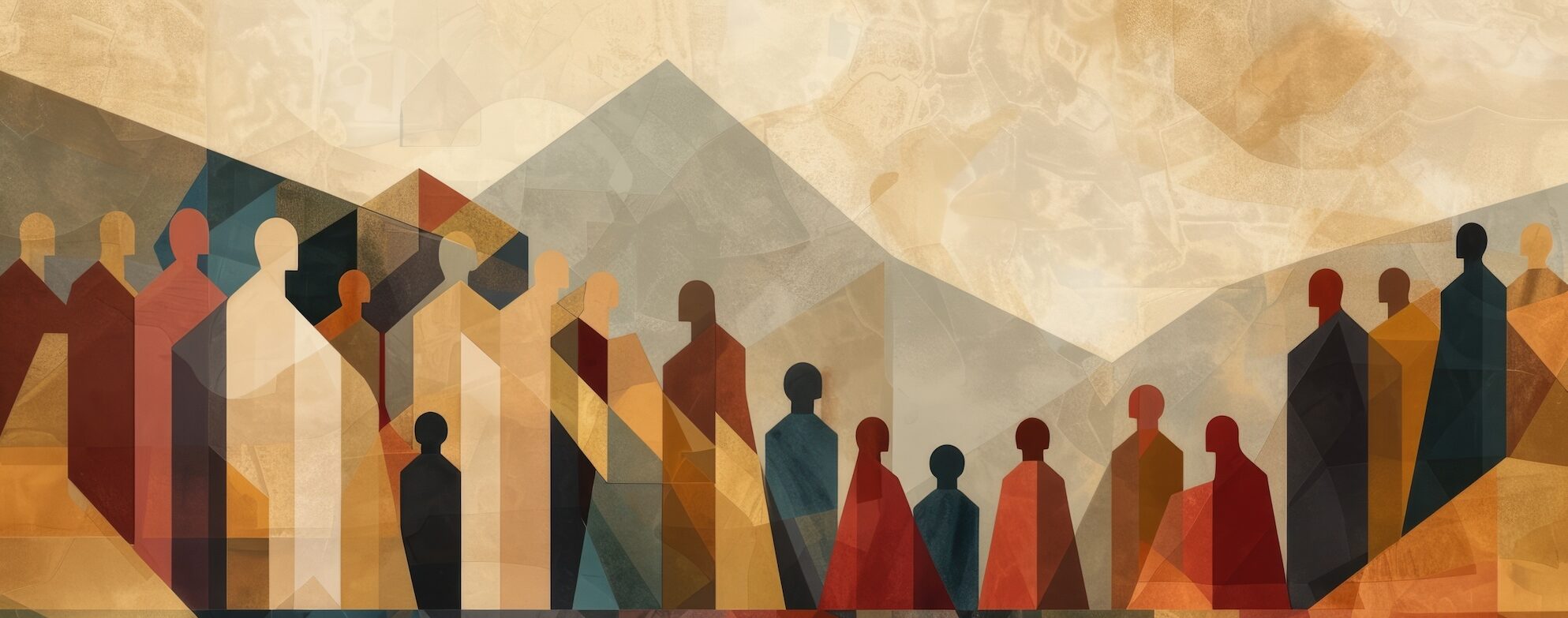Weeks before the world stopped and we were left wondering when or whether it would start up again, I sat alone in the last row of pews in a musty Oakland church. I was there seeking communion—an experience with which we’d all soon be intimately familiar.
Toward the end of the service, I made my way slowly to the front of the sanctuary, hands cupped before me like a beggar. Though we didn’t know it then, this would be the final time we would be in the same room as the bread was taken in hand, raised with gratitude, and torn in two with an audible rrrip. It was the last time we would share space as the old familiar words were spoken:
Take, eat; this is My body which is given for you: do this in remembrance of Me.
It was the last time we would hear the wine hit the bottom of the chalice and echo as it swirled and filled the cup, as the words of institution were offered:
This cup is the new testament in My blood: do this, as often as you drink it, in remembrance of Me.
In this ancient tradition of communion, I am finding anew a challenge to our beloved and dangerous myth of self-sufficiency. Around this simultaneously sacred and ordinary meal, I am finding if not a panacea at least the start of a way forward, a way out of our pandemic of isolation and endemic loneliness, toward mutual healing and life-giving dependency. It is here, in the preparation and sharing of meals, where I am finding the love that knits us together, the abundance of non-autonomy.
+ + +
In a non-hyperbolic sense, cooking kept me alive during the past two years. Not simply eating, but the liturgy of preparing and cooking meals kept me going month after month of wondering when it would all be over. As was the case for others, I looked for communion amidst virtual church services, remote learning, remote work, and felt only overwhelming isolation.
This feeling intensified when nine months into the pandemic, I moved away from the Bay Area for work. Like so many others, my experience of the pandemic involved an exile, a return home. Ten years and two degrees after leaving the Pacific Northwest and five years into my first full-time ministry role, I returned to my home state. It felt less like a homecoming than a move to a new city. I arrived in Seattle in the thick of winter and the continued isolation of this global pandemic. The confluence of the two produced, it seems to me now, what is arguably the worst time to move to the Pacific Northwest.
As I unpacked my things in my first apartment on my own in my life, my mind frequently retraced its footsteps to the Bay Area. I pictured old friends, wishing I could text someone to meet up for an end-of-day run, or for morning coffee and a walk along the waterfront.
I spent an exhausting amount of time each day running through a mental list of friends’ names and faces—people I hadn’t heard from in weeks, months—wondering if we were still friends. Looking back on those first two dozen months of the pandemic, marked by loss of family, loss of church community, loss of work, I wonder how many of my friends were doing the same.
A month after arriving in Seattle, on a Friday afternoon Zoom call with my supervisor (the one who brought me back to the Pacific Northwest) she told me that I was no longer “a good fit” for the job. In this new city in my old home state, I felt more alone than ever.
Bewildered, sleepless, and desperate for communion, I began reaching out to old friends and prospective friends alike.
“Let’s check in in a few months,” I heard. “Hopefully it’ll be better then.”
Returning home, I learned, means returning to our most elemental hungers.
Turning on some jazz music in the kitchen, I chop onions, celery, carrots. I thaw chicken thighs in the sink. Boiling chicken stock, I prepare soup.
+ + +
The pandemic took many things from us. Cooking with my son has been one of the rare gifts of these pandemic times.
For months, my son and I consistently begin our Saturday mornings together baking homemade biscuits. Steadily tweaking a standby recipe, we make it our own until we have it perfected (cold butter is key).
Measuring out the dry ingredients, Hudson and I work side-by-side in the kitchen—pouring the milk and cracking the eggs, mixing it all together, and then patiently rolling out the dough, over and over and over again.
We cut out large coin-shaped pieces of dough using an empty glass and place them in even rows on a cookie sheet together. Hudson watches as I push them into the piping hot oven.
We set the table with orange juice, honey, more butter, and strawberry jam. Ten minutes later, I remove a sheet of puffy biscuits from the oven. After peeling them apart, watching the steam rise, we slather the hot biscuits in butter and jam.
They are perfect.
At church on Father’s Day, 15 months into the pandemic, someone asks Hudson his favorite activity to do with his dad.
“Cooking,” he says.
+ + +
When I arrived in Seattle, I immediately began looking for a place to serve—preferably one involving cooking and sharing time with people. This is where I feel most myself, most alive.
After months of emails and asking around, I find Edible Hope Kitchen. Following another string of introductory emails and Zoom safety training classes, I find my way to a church basement in the heart of Ballard. In this subterranean kitchen, I meet Bernadette who hands me a potato peeler.
Together, we prepare shepherd’s pie and fresh fruit salad. Over nineties R&B music and chopping potatoes and slicing apples, we share laughter and stories of cross-country moves and things we miss about our old cities.
“There’s no place like Central Park,” Bernadette insists. “No place.”
Before arriving, I read several reviews of the church. Some neighbors shared that this church was drawing members of the homeless community to its front doors. They meant it as a complaint.
Bernadette and I prepare meals most Tuesday nights. The extended time together, chopping, mixing, cooking, and cleaning, offers plenty of time for conversation. On many nights I share with Bernadette about the joys of my relationship with my son—often over preparing food—as well as the strained relationship with my daughter, the weeks and months that pass without seeing her.
“Don’t stop, Ryan,” Bernadette says in a matter-of-fact voice. “Don’t ever stop loving her. Keep doing what you’re doing. Be patient.”
Hers is a somatic wisdom I am learning to trust most in this season.
+ + +
One Tuesday night when I show up to the basement kitchen, a new volunteer is peeling potatoes. At some point in the evening, the conversation turns to the tent community making their home in the park directly across the street from the church.
“They live there,” the new volunteer says, nodding his head in the direction of the park, “and they come here for food. So, you’re enabling them?”
I notice Bernadette, who cocks her head and squints her eyes. She doesn’t say a word.
In my months of working with Bernadette in this underground kitchen—chopping onions, peeling potatoes, mixing raw chicken thighs with fresh herbs and soy or Worcestershire sauce, filling stuffed bell peppers with ground beef and loads of powdered garlic—not once do I hear her refer to “the homeless.” I only ever hear her refer to her “neighbors,” often by name.
+ + +
Early in the pandemic, before my move to the Pacific Northwest, I began serving at City Hope, a community kitchen in the Tenderloin district of San Francisco. Preparing breakfast burritos, handing out coffee, and helping to create communion around those tables was exactly what I needed in that time of deep isolation.
I was taken aback by the number of thank you’s I received.
Another thing that took me aback: the sound of my name on strangers’ lips. Not a generic, “thanks,” but, “thanks, Ryan”—over and over again. Eight months into the pandemic, I couldn’t remember the last time I’d heard my name so much.
When I shared with a friend how taken aback I was and how good it felt, she was unsurprised.
“They know what it feels like to be unseen,” she said.
Preparing and sharing meals offers us space where strangers can become neighbors. In this space, we learn that we need one another if we’re going to make it out alive. In communion, we are reminded that we belong.
+ + +
Even when I was unemployed and spending my days, weeks, and months applying to job after job at the height of the pandemic’s restrictions, I kept my subscription to The New York Times Cooking. The recipes have been a life-giving source of creativity when my own has felt bone dry.
Quick chicken and dumplings soup has become a standby recipe during the pandemic. Name aside, it is slow to prepare, involving plenty of tactile preparation. “Flavor is a function of time,” Patrick Rosal writes.
The night before my son’s sixth birthday, I’m chopping leeks and celery and carrots and fresh rosemary and a whole chicken until nearly midnight for the aforementioned “quick” chicken and dumplings soup—my son’s request. Accompanying the jazz music, the smell of these ingredients simmering in liberal pads of butter delights my senses on a Friday night and fills my home with an aromatic comfort.
Pouring generous amounts of heavy cream and golden chicken broth into the large blue Dutch oven, I bring the mixture of fresh cut vegetables and herbs and liquids to a boil before adding the gnocchi (off-the-shelf dumplings, presumably the “quick” part of the recipe) and then, finally, an entire chicken, de-boned and chopped into bite-sized pieces. After the soup has cooled, I place the brimming Dutch oven in the fridge to sit overnight, allowing the ingredients to bloom into their fullest expression.
The next night, gathered around a table with Hudson’s favorite meal served alongside hot-out-of-the-oven garlic bread, a small group of newfound friends and my mother share their favorite things about my son.
“Your joy is contagious, Hudson.”
“You’re a good friend.”
“You are kind, Hudson. I never worry about my boys when they’re around you.”
“You’re so proudly yourself. You are your own person.”
I watch Hudson at the head of the table, spoon in hand, receiving this generous love with a smile.
Communion, I am learning, is the distillation of our Christian tradition. When you boil it all down, it is here, in edible, sharable form, where we find the heart of our faith.
+ + +
Twenty-four months into the pandemic, two young girls and their mother join Bernadette and me in the church basement kitchen. Our weekly liturgy of chopping vegetables and mixing meat with spices and herbs from the church’s garden is invigorated by their youthful presence. They confidently use large knives to chop onions, wiping the tears from their eyes with the back of their hand, all without complaining.
Several weeks later, standing on the church basement steps on his spring break, Hudson greets Bernadette with a sheepish green. She wraps him in a hug. While I help with his apron, the young girls and their mother arrive. His sheepishness deepens.
Bernadette invites us to prepare onions for chicken fajitas that will be served the next day. After asking Hudson what we need to begin, I pull out an oversized white cutting board and several knives. I clean a bunch of green onions for us and then line them up in a neat row.
Taking a large knife in hand, my hands frame Hudson’s as we chop.
“Can I do the next one on my own?” he asks, the first green onion now in a small pile. I oblige.
Without removing his eyes from the large knife or the pile of onions before him, Hudson works his way through each onion. His slices are a little wide, but otherwise perfect.
When we finish, Hudson asks what else he can do to help. Soon, he and the two young girls are up to their elbows in raw chicken thighs, mixing them in garlic salt and Worcestershire sauce and fresh basil.
Stopping what I’m doing, I walk across the kitchen to where Bernadette is working. I wrap her in the tightest side hug I can muster.
“Okay,” she says with a laugh, after a pause. “I got you, Ryan. I got you.”
At the end of the evening, I show Hudson where to put his apron so it can be washed. Before leaving, without being told to, he embraces Bernadette in a hug.
“I hope to see you again soon,” she tells him.
Months later, Hudson and I are cuddled on the couch watching Hostile Planet, a new favorite show. I’m struck by the revelation that, time and time again, the creatures who do not make it—penguins in Antarctica, mountain goats high in the Andes, or bison roaming the Great Plains—are those who become separated from their pack. A central part of humanity’s problem, Rowan Williams has suggested, is that we forget we are creatures, too.
+ + +
In an effort to lean more of my weight into the forced wintering season of this pandemic, I have begun making my own chicken stock.
Saving the carcass whenever I roast a whole chicken, especially comforting on Sundays, I return it to the Dutch oven, blanket the bones with whatever chopped vegetables I have on hand—always onions (including the ends, as Bernadette encourages), usually celery, carrots, and fresh rosemary, if I have it. I bathe the mixture in six cups of water, add liberal amounts of fresh ground black pepper and salt, boil it all down, then wait as it distills into its nutritious essence. Overnight is best, if possible.
The next day, a bouquet of smells rises from the pot when I finally remove the lid. Placing a strainer over a mixing bowl, I pour the liquid from the Dutch oven through the strainer. Then, I pour the golden liquid in the mixing bowl into mason jars and allow it to cool before being refrigerated.
When I use my first batch of from-scratch chicken stock to prepare jasmine rice, my mouth is overwhelmed with flavor. All that life, distilled into this fragrant, golden liquid. More than delicious, it is healing.
+ + +
After everything that’s happened in the past few years, I vividly remember making my way to the front of the Oakland sanctuary that Sunday morning in March before gathering in person became an impossibility. I remember being greeted by name with broken bread and a cup of wine.
This is Jesus’s body, Ryan, broken for you. This is Jesus’s blood, poured out for you…
Then, this Oakland pastor added four words to this familiar liturgy. Words I hunger for most, then as now: …because He loves you.
Cover photo credit: Duncan Kidd



